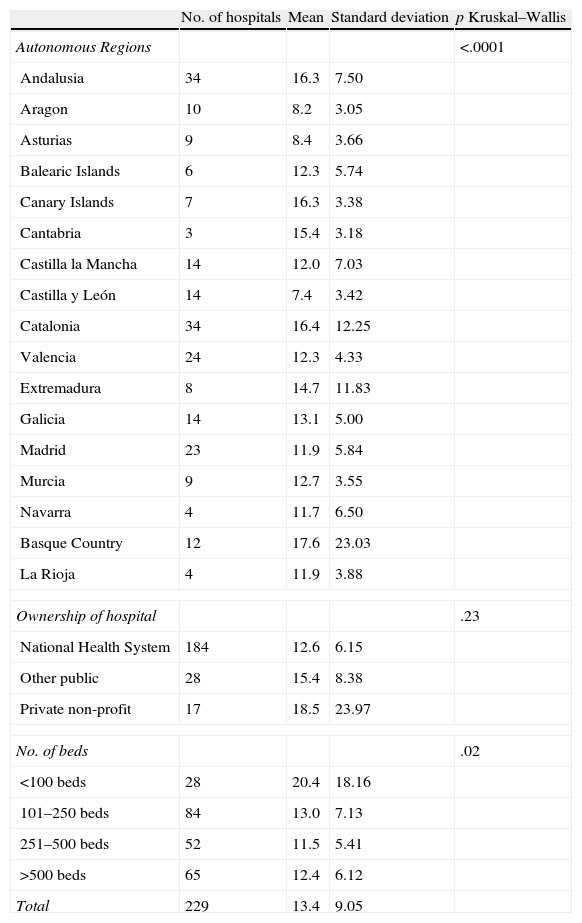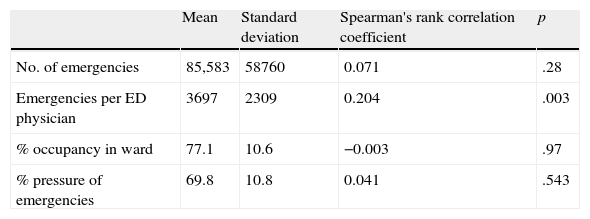Deaths in emergency departments (ED) should only occur in rare cases. The aim of the study was to describe the distribution of deaths in Spanish hospitals in two locations: the ED or pre-admission and in-hospital or post-admission, and their geographical distribution and possible conditioning factors.
Patients and methodsThe study was ecological. The percentage of hospital deaths prior to admission (PHDPA) compared to total hospital deaths for each center was calculated. The information was obtained from the “2009 Survey of Health Care Establishments with In-Patient facilities”. This survey included information for all the Spanish hospitals. It analyzed geographical variability and its relation to the characteristics of the centers and various indicators of health care activity using non-parametric tests.
ResultsThe PHDPA was 13.4%, with wide variability between regions: from 7.4% to 16.4%. PHDPA was higher in hospitals with fewer than 100 beds and those with a higher average of emergencies per ED physician.
ConclusionsOur study reveals the important variability in PHDPA. We estimate that if 80% of those patients who had died in the ED had died in the hospital ward, hospital stays would only have been increased by less than 0.1%.
Las muertes en los servicios de urgencias hospitalarios (SUH) deberían ocurrir solo en casos muy puntuales. El objetivo del estudio fue describir la distribución de las muertes en hospitales españoles en los SUH (previas al ingreso) y en las unidades de hospitalización (posteriores al ingreso), así como su distribución geográfica y sus posibles condicionantes.
Pacientes y métodosEl estudio fue ecológico. Se calculó el porcentaje de muertes hospitalarias previas al ingreso (PMHPI) respecto al total de muertes hospitalarias para cada centro a partir de la «Encuesta de Establecimientos Sanitarios con Régimen de Internado de 2009», que incluye información de todos los hospitales españoles. Se analizó su variabilidad geográfica y su relación con las características de los centros y diversos indicadores de actividad asistencial mediante pruebas no paramétricas.
ResultadosEl PMHPI se situó en el 13,4%, con una amplia variabilidad entre comunidades autónomas (rango 7,4–16,4%). El PMHPI fue mayor en los hospitales de menos de 100 camas y en aquellos con mayor promedio de urgencias anuales por facultativo del SUH.
ConclusionesNuestro estudio desvela la importante variabilidad del PMHPI. Estimamos que si el 80% de los pacientes fallecidos en SUH lo hubieran hecho en planta, las estancias hospitalarias se hubieran incrementado en menos del 0,1%.
Article
Diríjase desde aquí a la web de la >>>FESEMI<<< e inicie sesión mediante el formulario que se encuentra en la barra superior, pulsando sobre el candado.

Una vez autentificado, en la misma web de FESEMI, en el menú superior, elija la opción deseada.

>>>FESEMI<<<








